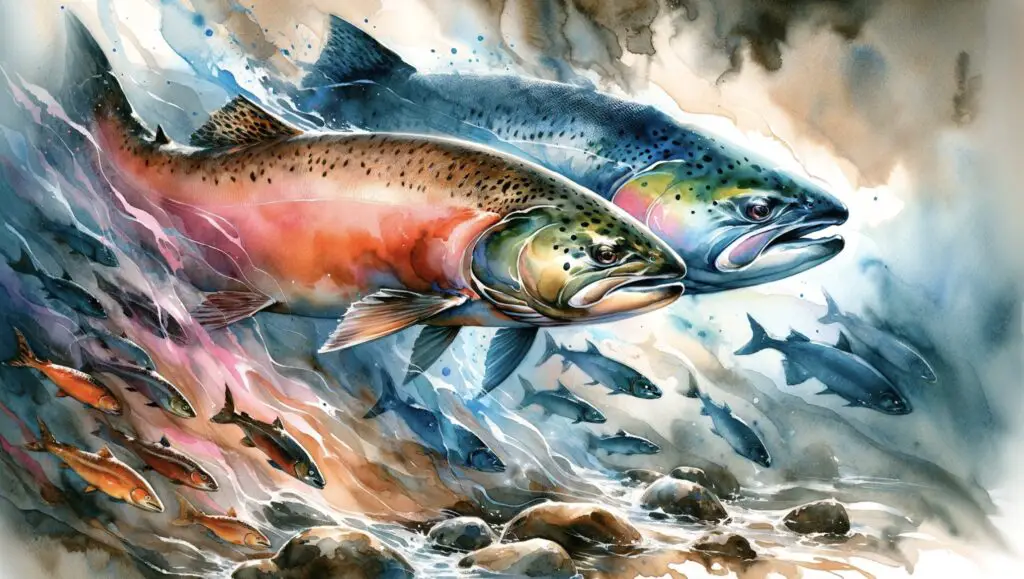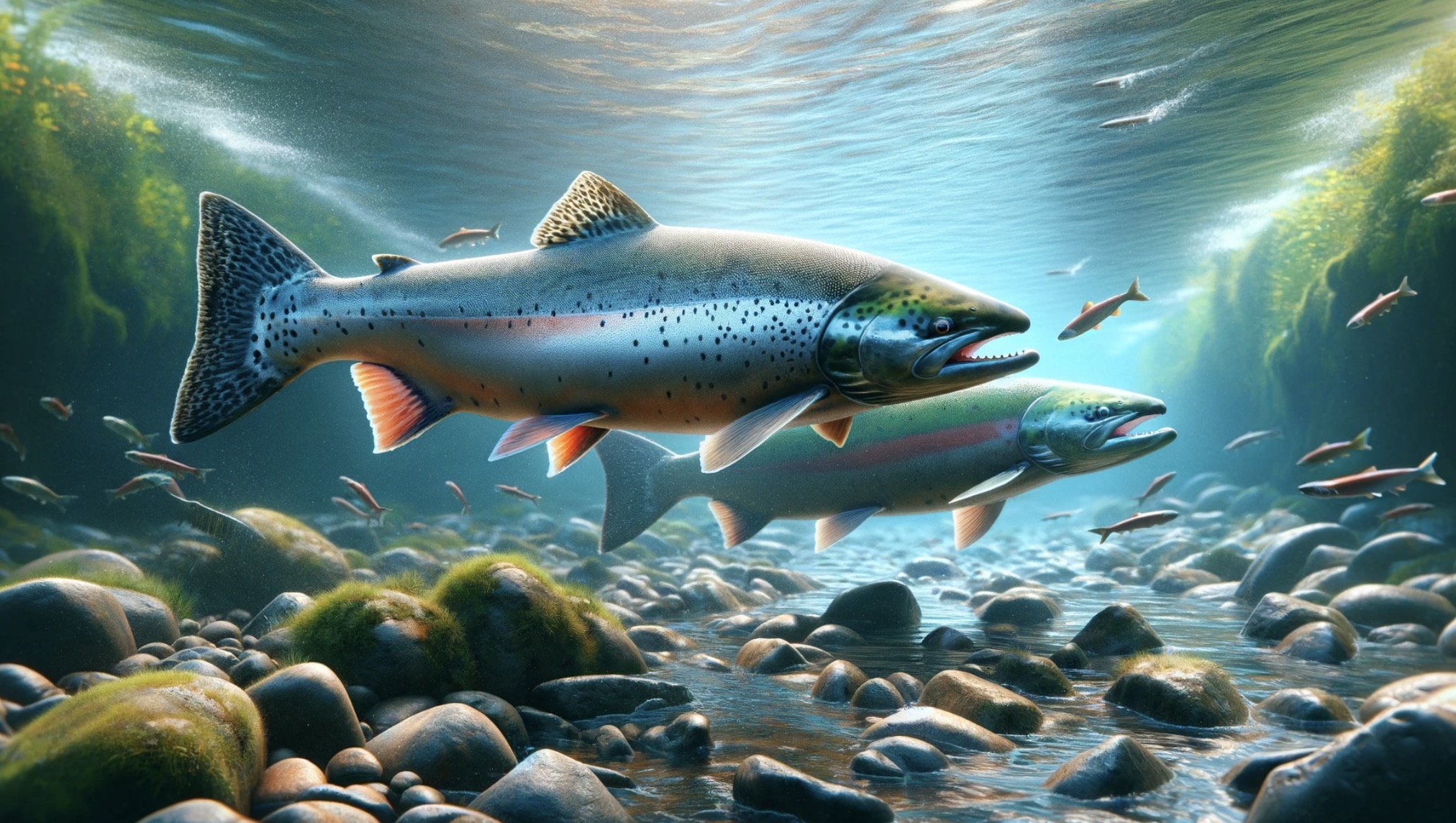The main difference between male and female salmon lies in their physical features and behavior, particularly during spawning season.
As a marine biologist, I’ve spent countless hours studying and observing various marine species, and one species that has always fascinated me is the salmon. Salmon are remarkable creatures, not only for their delicious taste but also for their unique life cycle and the incredible journey they undertake during spawning season.
In this blog post, I will be sharing my knowledge and first-hand experience on how to tell the difference between a male and female salmon. I’ll cover the various physical features and behavioral traits that can help you distinguish between the two sexes, particularly during the spawning season when these differences are most significant.
Physical Features
Body Shape
One of the most noticeable differences between male and female salmon is their body shape. In general, male salmon tend to be larger and more robust than their female counterparts. Males typically have a more elongated body, with a prominent dorsal hump, while females have a more streamlined and sleek body shape.
During the spawning season, these differences become even more pronounced. Male salmon develop a hooked snout, known as a “kype,” which is used to defend their territory and to fight other males for access to females. Female salmon do not develop a kype and maintain a more rounded snout.

Coloration
The coloration of salmon is another key indicator that can help you tell the difference between male and female individuals. In general, both sexes exhibit a silver, blue, or green coloration on their back, with a lighter shade on their sides and belly.
However, during the spawning season, both sexes undergo changes in their coloration to attract mates and deter potential rivals.
Male salmon typically develop a brighter, more vibrant coloration than females, with their bodies taking on shades of red, pink, or orange.
The intensity of these colors can vary depending on the species, but in general, the males are more vividly colored during spawning season. Female salmon, on the other hand, may develop a more subdued coloration, with their bodies taking on a darker, more camouflaged appearance.
Fin Size and Shape
Another physical characteristic that can help you distinguish between male and female salmon is the size and shape of their fins. Male salmon tend to have larger, more developed fins than females, particularly their dorsal and anal fins.
The dorsal fin is the one located on the fish’s back, while the anal fin is found on the underside, near the tail.
During the spawning season, the male’s fins become even more pronounced, with the dorsal and anal fins developing a more elongated, pointed shape. This helps them to maneuver more effectively in the water and to maintain their position near the female during the courtship process.
Scale Pattern
While not as obvious as the other physical features mentioned above, the scale pattern on a salmon’s body can also provide clues about its sex. Male salmon tend to have larger, more widely spaced scales than females.
This difference is most noticeable on the fish’s sides, where the scales of a male salmon are often arranged in a more irregular pattern compared to the more uniform arrangement of a female’s scales.
Behavioral Differences
Spawning Behavior
During the spawning season, male and female salmon exhibit distinct behavioral differences that can help you tell them apart. Males become more aggressive and territorial, actively defending their chosen nesting sites from rival males.
They will engage in fierce battles, using their hooked snouts and powerful bodies to push and bite their competitors. Female salmon, on the other hand, focus on finding a suitable nesting site and preparing it for the arrival of their eggs.
Courtship Display
When a female salmon has chosen a suitable nesting site, she will begin her courtship display to attract a male partner. This display involves a series of rapid, vertical movements in the water, accompanied by the release of pheromones that signal her readiness to spawn.
Male salmon, in turn, respond to these displays by swimming alongside the female and attempting to impress her with their bright coloration and vigorous swimming.
Nesting Behavior
Once a male salmon has successfully courted a female, the pair will begin the process of building their nest, known as a “redd.” The female salmon uses her powerful tail to dig a shallow depression in the gravel or sand, while the male stands guard nearby.
Once the nest is complete, the female will deposit her eggs, and the male will release his sperm to fertilize them. Afterward, the female will cover the eggs with gravel to protect them from predators and the elements.
In conclusion, the differences between male and female salmon can be identified through their physical features and behaviors, particularly during spawning season. To help you remember these differences, here are 10 key facts:
1. Male salmon are generally larger and more robust than females.
2. Males develop a hooked snout (kype) during spawning season, while females maintain a rounded snout.
3. Male salmon have a more vibrant coloration during spawning season compared to females.
4. Males have larger, more developed fins than females, particularly the dorsal and anal fins.
5. Male salmon have larger, more widely spaced scales than females.
6. During spawning season, males become more aggressive and territorial.
7. Female salmon focus on finding and preparing a suitable nesting site during spawning season.
8. Courtship displays involve rapid, vertical movements and pheromone release from the female, with the male responding by swimming alongside her.
9. Males and females work together to build a nest (redd) for their eggs.
10. After spawning, the female covers the eggs with gravel to protect them from predators and the elements.
FAQs
What are the characteristics of a female salmon?
Female salmon typically have a larger body size, a rounder head shape, and a more pronounced hooked jaw than males. They also have a larger and more developed reproductive system, including ovaries and a spawning canal. During the breeding season, females will develop a reddish coloration on their underbelly, and may have a slightly curved tail fin.
Are red salmon good to eat?
Yes, red salmon (also known as sockeye salmon) are good to eat. They are a rich source of omega-3 fatty acids, high-quality protein, and essential vitamins and minerals. Additionally, red salmon have a distinct, delicious flavor that makes them a popular choice for seafood dishes.
What are the characteristics of a salmon?
Salmon are typically characterized by their elongated, streamlined bodies, silver or blue-green scales, and a pinkish-orange flesh. They are also known for their ability to swim upstream to spawn and their unique life cycle that includes hatching in freshwater, migrating to the ocean, and returning to freshwater to reproduce.
Why do male salmon turn red?
Male salmon turn red during the spawning season as a result of hormonal changes that cause an increase in the production of carotenoid pigments. These pigments are deposited in the skin, giving the fish their characteristic red coloration. This coloration is thought to play a role in attracting females and establishing dominance over other males during the breeding season.
Do only male salmon turn red?
No, both male and female salmon can turn red during spawning season.
Are male or female salmon better to eat?
There is no significant difference in taste or nutritional value between male and female salmon, so both are equally good to eat.




